|
|
|
|
 |
RODENTS: Beavers |
|
|
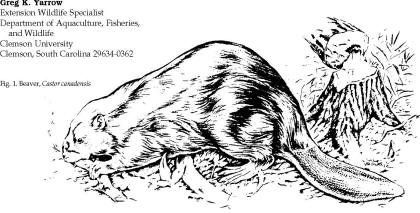
Identification

 The
beaver (Castor canadensis, Fig. 1) is the largest North
American rodent. Most adults weigh from 35 to 50 pounds
(15.8 to 22.5 kg), with some occasionally reaching 70 to
85 pounds (31.5 to 38.3 kg). Individuals have been known
to reach over 100 pounds (45 kg). The beaver is a stocky
rodent adapted for aquatic environments. Many of the
beaver’s features enable it to remain submerged for long
periods of time. It has a valvular nose and ears, and
lips that close behind the four large incisor teeth.
Each of the four feet have five digits, with the hind
feet webbed between digits and a split second claw on
each hind foot. The front feet are small in comparison
to the hind feet (Fig. 2). The underfur is dense and
generally gray in color, whereas the guard hair is long,
coarse and ranging in color from yellowish brown to
black, with reddish The
beaver (Castor canadensis, Fig. 1) is the largest North
American rodent. Most adults weigh from 35 to 50 pounds
(15.8 to 22.5 kg), with some occasionally reaching 70 to
85 pounds (31.5 to 38.3 kg). Individuals have been known
to reach over 100 pounds (45 kg). The beaver is a stocky
rodent adapted for aquatic environments. Many of the
beaver’s features enable it to remain submerged for long
periods of time. It has a valvular nose and ears, and
lips that close behind the four large incisor teeth.
Each of the four feet have five digits, with the hind
feet webbed between digits and a split second claw on
each hind foot. The front feet are small in comparison
to the hind feet (Fig. 2). The underfur is dense and
generally gray in color, whereas the guard hair is long,
coarse and ranging in color from yellowish brown to
black, with reddish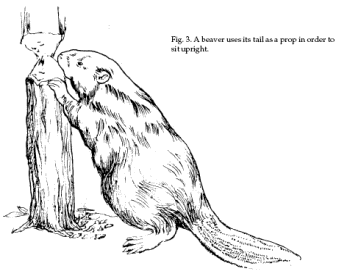 brown the most common coloration. The prominent tail is
flattened dorsoventrally, scaled, and almost hairless.
It is used as a prop while the beaver is sitting upright
(Fig. 3) and for a rudder when swimming. Beavers also
use their tail to warn others of danger by abruptly
slapping the surface of the water. The beaver’s large
front (incisor) teeth, bright orange on the front, grow
continuously throughout its life. These incisors are
beveled so that they are continuously sharpened as the
beaver gnaws and chews while feeding, girdling, and
cutting trees. The only way to externally distinguish
the sex of a beaver, unless the female is lactating, is
to feel for the presence of a baculum (a bone in the
penis) in males and its absence in females.
brown the most common coloration. The prominent tail is
flattened dorsoventrally, scaled, and almost hairless.
It is used as a prop while the beaver is sitting upright
(Fig. 3) and for a rudder when swimming. Beavers also
use their tail to warn others of danger by abruptly
slapping the surface of the water. The beaver’s large
front (incisor) teeth, bright orange on the front, grow
continuously throughout its life. These incisors are
beveled so that they are continuously sharpened as the
beaver gnaws and chews while feeding, girdling, and
cutting trees. The only way to externally distinguish
the sex of a beaver, unless the female is lactating, is
to feel for the presence of a baculum (a bone in the
penis) in males and its absence in females.
Range
 Beavers
are found throughout North America, except for the
arctic tundra, most of peninsular Florida, and the
southwestern desert areas (Fig. 4). The species may be
locally abundant wherever aquatic habitats are found. Beavers
are found throughout North America, except for the
arctic tundra, most of peninsular Florida, and the
southwestern desert areas (Fig. 4). The species may be
locally abundant wherever aquatic habitats are found.
Habitat
Beavers have a relatively
long life span, with individuals known to have lived to
21 years. Most, however, do not live beyond 10 years.
The beaver is unparalleled at dam building and can build
dams on fast-moving streams as well as slow-moving ones.
They also build lodges and bank dens, depending on the
available habitat. All lodges and bank dens have at
least two entrances and may have four or more. The lodge
or bank den is used primarily for raising young,
sleeping, and food storage during severe weather (Fig.
5).
Fig. 5. Cross section of a
beaver lodge.
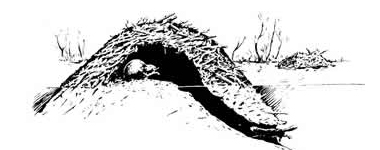
The size and species of
trees the beaver cuts is highly variable — from a 1-inch
(2.5-cm) diameter at breast height (DBH) softwood to a
6-foot (1.8-m) DBH hardwood. In some areas beavers
usually cut down trees up to about 10 inches (25 cm) DBH
and merely girdle or partially cut larger ones, although
they often cut down much larger trees. Some beavers seem
to like to girdle large pines and sweet-gums. They like
the gum or storax that seeps out of the girdled area of
sweet-gum and other species.
An important factor about
beavers is their territoriality. A colony generally
consists of four to eight related beavers, who resist
additions or outsiders to the colony or the pond. Young
beavers are commonly displaced from the colony shortly
after they become sexually mature, at about 2 years old.
They often move to another area to begin a new pond and
colony. However, some become solitary hermits inhabiting
old abandoned ponds or farm ponds if available.
Beavers have only a few
natural predators aside from humans, including coyotes,
bobcats, river otters, and mink, who prey on young
kittens. In other areas, bears, mountain lions, wolves,
and wolverines may prey on beavers. Beavers are hosts
for several ectoparasites and internal parasites
including nematodes, trematodes, and coccidians. Giardia
lamblia is a pathogenic intestinal parasite transmitted
by beavers, which has caused human health problems in
water supply sys-tems. The Centers for Disease Control
have recorded at least 41 outbreaks of waterborne
Giardiasis, affecting more than 15,000 people. For more
information about Giardiasis, see von Oettingen (1982).
Damage and
Damage Identification
 The
habitat modification by beavers, caused primarily by dam
building, is often beneficial to fish, furbearers,
reptiles, amphibians, waterfowl, and shorebirds.
However, when this modification comes in conflict with
human objectives, the impact of damage may far outweigh
the benefits. The
habitat modification by beavers, caused primarily by dam
building, is often beneficial to fish, furbearers,
reptiles, amphibians, waterfowl, and shorebirds.
However, when this modification comes in conflict with
human objectives, the impact of damage may far outweigh
the benefits.
Most of the damage caused
by beavers is a result of dam building, bank burrowing,
tree cutting, or flooding. Some southeastern states
where beaver damage is extensive have estimated the cost
at $3 million to $5 million dollars annually for timber
loss; crop losses; roads, dwellings, and flooded
property; and other damage. In some states, tracts of
bottomland hardwood timber up to several thousand acres
(ha) in size may be lost because of beaver. Some unusual
cases observed include state highways flooded because of
beaver ponds, reservoir dams destroyed by bank den
burrows collapsing, and train derailments caused by
continued flooding and burrowing. Housing developments
have been threatened by beaver dam flooding, and
thousands of acres (ha) of cropland and young pine
plantations have been flooded by beaver dams (Fig. 6).
Road ditches, drain pipes, and culverts have been
stopped up so badly that they had to be dynamited out
and replaced. Some bridges have been destroyed because
of beaver dam-building activity. In addition, beavers
threaten human health by contaminating water supplies
with Giardia.
Identifying beaver damage
generally is not difficult. Signs include dams;
dammed-up culverts, bridges, or drain pipes resulting in
flooded lands, timber, roads, and crops; cut-down or
girdled trees and crops; lodges and burrows in ponds,
reservoir levees, and dams. In large watersheds, it may
be difficult to locate bank dens. However, the limbs,
cuttings, and debris around such areas as well as dams
along tributaries usually help pinpoint the area.
Legal
Status
It is almost impossible as
well as cost-prohibitive to exclude beavers from ponds,
lakes, or impoundments. If the primary reason for
fencing is to exclude beavers, fencing of large areas is
not practical. Fencing of culverts, drain pipes, or
other structures can sometimes prevent damage, but
fencing can also promote damage, since it provides
beavers with construction material for dams. Protect
valuable trees adjacent to waterways by encircling them
with hardware cloth, woven wire, or other metal
barriers. Construction of concrete spillways or other
permanent structures may reduce the impact of beavers.
Cultural Methods
Because beavers usually
alter or modify their aquatic habitat so extensively
over a period of time, most practices generally thought
of as cultural have little impact on beavers. Where
feasible, eliminate food, trees, and woody vegetation
that is adjacent to beaver habitat. Continual
destruction of dams and removal of dam construction
materials daily will (depending on availability of
construction materials) sometimes cause a colony or
individual beavers to move to another site. They might,
however, be even more troublesome at the new location.
The use of a three-log
drain or a structural device such as wire mesh culverts
(Roblee 1983) or T-culvert guards (Roblee 1987) will
occasionally cause beavers to move to other areas. They
all prevent beavers from controlling water levels.
However, once beavers have become abundant in a
watershed or in a large contiguous area, periodic
reinvasions of suitable habitat can be expected to
occur. Three-log drains have had varying degrees of
success in controlling water levels in beaver
impoundments, especially if the beaver can detect the
sound of falling water or current flow. All of these
devices will stimulate the beavers to quickly plug the
source of water drainage.
A new device for
controlling beaver impoundments and keeping blocked
culverts open is the Clemson beaver pond leveler. It has
proven effective in allowing continual water flow in
previously blocked culverts/drains and facilitating the
manipulation of water levels in beaver ponds for
moist-soil management for waterfowl (Wood and Woodward
1992) and other environmental or aesthetic purposes. The
device (Fig. 7) consists of a perforated PVC pipe that
is encased in heavy-gauge hog wire. This part is placed
upstream of the dam or blocked culvert, in the main run
or deepest part of the stream. It is connected to
nonperforated sections of PVC pipe which are run through
the dam or culvert to a water control structure
downstream. It is effective because the beavers cannot
detect the sound of falling or flowing water as the pond
or culvert drains; therefore, they do not try to plug
the pipe. The Clemson beaver pond leveler works best in
relatively flat terrain where large volumes of water
from watersheds in steep terrain are not a problem.
Repellents
There are no chemical repellents registered for
beavers. Past research efforts have tried to determine
the effectiveness of potential repellent materials;
however, none were found to be effective,
environmentally safe, or practical. One study in Georgia
(Hicks 1978) indicated that a deer repellent had some
potential benefit. Other studies have used a combination
of dam blowing and repellent soaked (Thiram 80 and/or
paradichlorobenzene) rags to discourage beavers with
varying degrees of success (Dyer and Rowell 1985).
Additional research is
needed on repellents for beaver damage prevention.
Toxicants
None are registered. Research efforts have been
conducted, however, to find effective, environmentally
safe and practical toxicants. Currently there are none
that meet these criteria.
Fumigants
None are registered.
Trapping
The use of traps in most situations where beavers
are causing damage is the most effective, practical, and
environmentally safe method of control. The
effectiveness of any type of trap for beaver control is
dependent on the trapper’s knowledge of beaver habits,
food preferences, ability to read beaver signs, use of
the proper trap, and trap placement. A good trapper with
a dozen traps can generally trap all the beavers in a
given pond (behind one dam) in a week of trap nights.
Obviously in a large watershed with several colonies,
more trapping effort will be required. Most anyone with
trapping experience and some outdoor “savvy” can become
an effective beaver trapper in a short time. In an area
where beavers are common and have not been exposed to
trapping, anyone experienced in trapping can expect good
success. Additional expertise and improved techniques
will be gained through experience.
A variety of trapping
methods and types of traps are effective for beavers,
depending on the situation. Fish and wildlife agency
regulations vary from state to state. Some types of
traps and trapping methods, although effective and legal
in some states, may be prohibited by law in other
states. Individual state regulations must be reviewed
annually before beginning a trapping program.
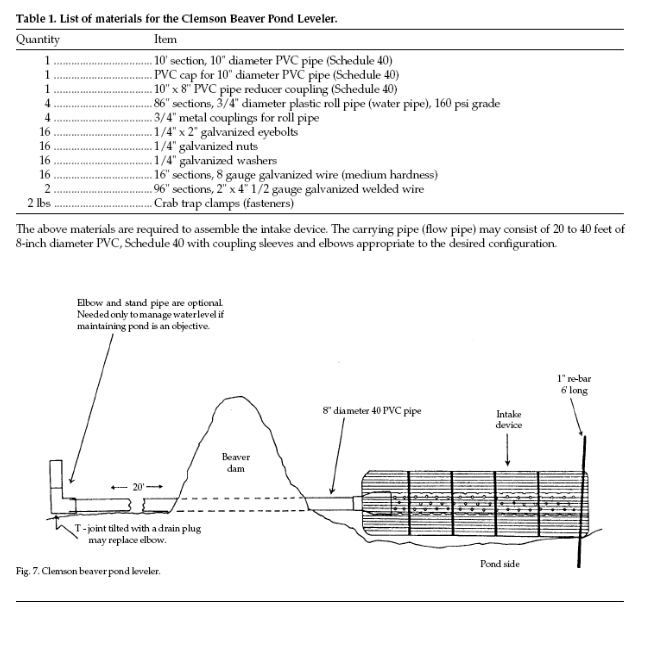
In some states where
beavers have become serious economic pests, special
regulations and exemptions have been passed to allow for
increased control efforts. For example, some states
allow trapping and snaring of beavers and other control
measures throughout the year. Others, however, prohibit
trapping except during established fur trapping seasons.
Some states allow exemptions for removal of beavers only
on lands owned or controlled by persons who are
suffering losses. In some states a special permit is
required from the state fish and wildlife agency.
Of the variety of traps
commonly allowed for use in beaver control, the Conibear®
type, No. 330, is one of the most effective (Fig. 8).
Not all trappers will agree that this type of trap is
the most effective; however, it is the type most
commonly used by professional trappers and others who
are principally trapping beavers. This trap kills
beavers almost instantly. When properly set, the trap
also prevents any escape by a beaver, regardless of its
size. Designed primarily for water use, it is equally
effective in deep and shallow water. Only one trap per
site is generally necessary, thus reducing the need for
extra traps. The trap exerts tremendous pressure and
impact when tripped. Appropriate care must be exercised
when setting and placing
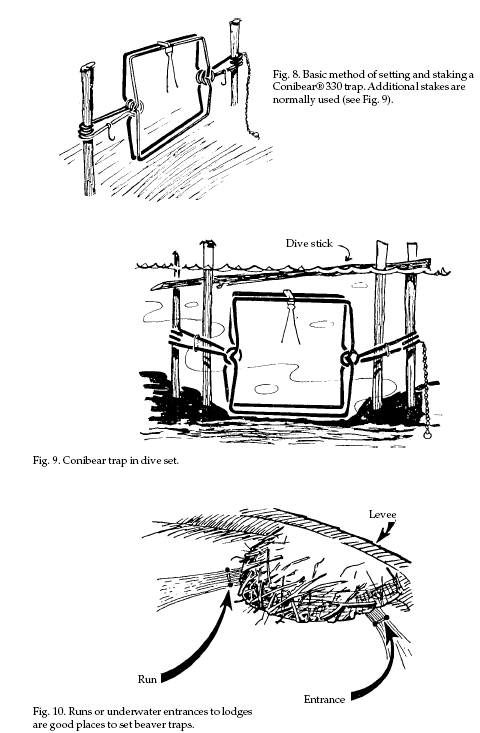 the
trap. Care should also be taken when using the Conibear®
type traps in urban and rural areas where pets
(especially dogs) roam free. Use trap sets where the
trap is placed completely underwater. the
trap. Care should also be taken when using the Conibear®
type traps in urban and rural areas where pets
(especially dogs) roam free. Use trap sets where the
trap is placed completely underwater.
Some additional equipment
will be useful: an axe, hatchet, or large cutting tool;
hip boots or waders; wire; and wire cutters. With the
Conibear®-type trap, some individuals use a device or
tool called “setting tongs.” Others use a piece of 3/8-
or 1/2-inch (9- or 13mm) nylon rope. Most individuals
who are experienced with these traps use only their
hands. Regardless of the techniques used to set the
trap, care should be exercised.
Earlier models of the
Conibear® type of trap came with round, heavy steel
coils which were dangerous to handle unless properly
used in setting the trap. They are not necessary to
safely set the trap. However, the two safety hooks, one
on each spring, must be carefully handled as each spring
is depressed, as well as during trap placement. On newer
models an additional safety catch (not attached to the
springs) is included for extra precaution against
inadvertent spring release. The last step before leaving
a set trap is to lift the safety hook attached to each
spring and slide the safety hook back from the trap
toward the spring eye, making sure to keep hands and
feet safely away from the center of the trap. If the
extra (unattached) safety catch is used, it should be
removed before the safety hooks that are attached to the
springs to keep it from getting in the way of the
movement of the safety hooks.
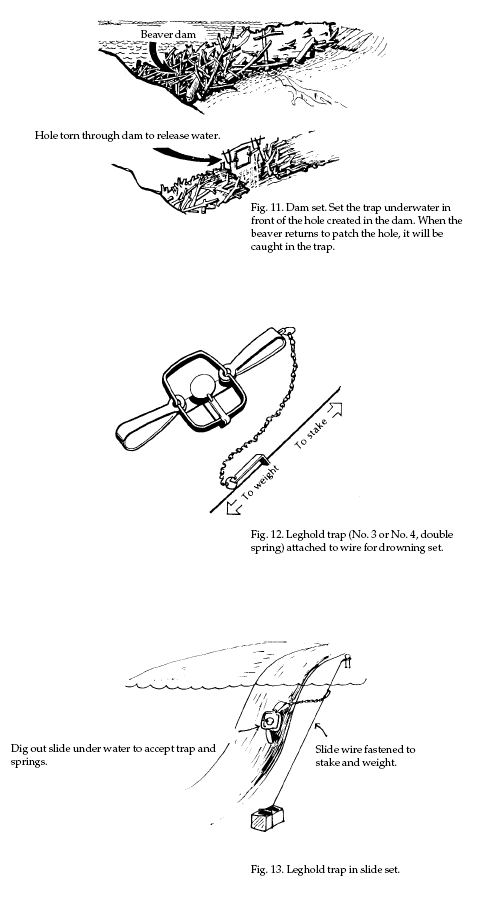 Conibear®-type
traps are best set while on solid ground with dry hands.
Once the springs are depressed and the safety hooks in
place, the trap or traps can be carried into the water
for proper placement. Stakes are needed to anchor the
trap down. In most beaver ponds and around beaver dams,
plenty of suitable stakes can be found. At least two
strong stakes, preferably straight and without forks or
snags, should be chosen to place through each spring eye
(Fig. 8). Additional stakes may be useful to put between
the spring arms and help hold the trap in place. Do not
place stakes on the outside of spring arms. Aside from
serving to hold the trap in place, these stakes also
help to guide the beaver into the trap. Where needed,
they are also useful in holding a dive stick at or just
beneath the water surface (Fig. 9). If necessary, the
chain and circle attached to one spring eye can be
attached to another stake. In deep water sets, a chain
with an attached wire should be tied to something at or
above the surface so the trapper can retrieve the trap.
Otherwise the trap may be lost. Conibear®-type
traps are best set while on solid ground with dry hands.
Once the springs are depressed and the safety hooks in
place, the trap or traps can be carried into the water
for proper placement. Stakes are needed to anchor the
trap down. In most beaver ponds and around beaver dams,
plenty of suitable stakes can be found. At least two
strong stakes, preferably straight and without forks or
snags, should be chosen to place through each spring eye
(Fig. 8). Additional stakes may be useful to put between
the spring arms and help hold the trap in place. Do not
place stakes on the outside of spring arms. Aside from
serving to hold the trap in place, these stakes also
help to guide the beaver into the trap. Where needed,
they are also useful in holding a dive stick at or just
beneath the water surface (Fig. 9). If necessary, the
chain and circle attached to one spring eye can be
attached to another stake. In deep water sets, a chain
with an attached wire should be tied to something at or
above the surface so the trapper can retrieve the trap.
Otherwise the trap may be lost.
Trap Sets. There are many
sets that can be made with a Conibear®-type trap (for
example, dam sets, slide sets, lodge sets, bank den
sets, “run”/trail sets, under log/dive sets, pole sets,
under ice sets, deep water sets, drain pipe sets),
depending on the trapper’s capability and ingenuity. In
many beaver ponds, however, most beavers can be trapped
using dam sets, lodge or bank den sets, sets in
“runs”/trails, dive sets or sets in slides entering the
water from places where beavers are feeding. Beavers
swim both at the surface or along the bottom of ponds,
depending on the habitat and water depth. Beavers also
establish runs or trails which they habitually use in
traveling from lodge or den to the dam or to feeding
areas, much like cow trails in a pasture.
Place traps directly
across these runs, staked to the bottom (Fig. 10).
Use a good stake or
“walking staff’ when wading in a beaver pond to locate
deep holes, runs, or trails. This will prevent stepping
off over waders or hip boots in winter, and will help
ward off cottonmouth snakes in the summer. The staff can
also help locate good dive holes under logs as you walk
out runs or trails. In older beaver ponds, particularly
in bottomland swamps, it is not uncommon to find runs
and lodge or bank den entrances where the run or hole is
2 to 3 feet (0.6 to 0.9 m) below the rest of the
impoundment bottom.
To stimulate nighttime
beaver movement, tear a hole in a beaver dam and get the
water moving out of a pond. Beavers quickly respond to
the sound of running water as well as to the current
flow. Timing is also important if you plan to make dam
sets. Open a hole in the dam about 18 inches to 2 feet
(46 to 60 cm) wide and 2 to 3 feet (60 to 90 cm) below
the water level on the upper side of the dam in the
morning. This will usually move a substantial amount of
water out of the pond before evening (Fig. 11). Set
traps in front of the dam opening late that same
evening. Two problems can arise if you set a trap in the
morning as soon as a hole is made: (1) by late evening,
when the beavers become active, the trap may be out of
the water and ineffective; or (2) a stick, branch, or
other debris in the moving water may trip the trap,
again rendering it ineffective.
The best dam sets are made
about 12 to 18 inches (30.8 to 45.7 cm) in front of the
dam itself. Using stakes or debris on either side of the
trap springs, create a funnel to make the beaver go into
the jaws of the trap. Always set the trigger on the
Conibear®-type trap in the first notch to prevent debris
from tripping it before the beaver swims into the trap.
The two heavy-gauge wire trippers can be bent outward
and the trigger can be set away from the middle if
necessary, to keep debris from tripping the trap. This
can also keep small beaver or possibly fish or turtles
from springing the trap. Double-spring leghold traps
have been used for hundreds of years and are still very
effective when properly used by skilled trappers. Use at
least No. 3 double (long) spring or coil spring type
leghold traps or traps of equivalent size jaw spread and
strength. Use a drowning set attachment with any leghold
trap (Fig. 12). As the traps are tripped, the beaver
will head for the water. A weight is used to hold the
trapped beaver underwater so that it ultimately drowns.
Some trappers stake the wire in deep water to accomplish
drowning. If leghold traps are not used in a manner to
accomplish drowning, there is a good likelihood that
legs or toes will be twisted off or pulled loose,
leaving an escaped, trap-wise beaver.
Placement is even more
critical with leghold traps than with the Conibear®-type.
Place leghold traps just at the water’s edge, slightly
underwater, with the pan, jaws, and springs covered
lightly with leaves or debris or pressed gently into the
pond bottom in soft mud. Make sure there is a cavity
under the pan so that when the beaver’s foot hits the
pan, it will trigger the trap and allow the jaws to snap
closed. Place traps off-center of the trail or run to
prevent “belly pinching” or missing the foot or leg.
With some experience, beaver trappers learn to make sets
that catch beavers by a hind leg rather than a front
leg. The front leg is much smaller and easier to twist
off or pull out.
Sometimes it’s wise, when
using leghold traps, to make two sets in a slide, run,
dam, or feeding place to increase trapping success and
remove beavers more quickly. In some situations, a
combination of trapping methods can shorten trapping
time and increase success.
Trappers have come up with
unique methods of making drown sets. One of the simplest
and most practical is a slide wire with a heavy weight
attached to one end, or with an end staked to the bottom
in 3 or more feet (>0.9 m) of water. The other end of
the wire is threaded through a hole in one end of a
small piece of angle iron. The trap chain is attached to
a hole in the other end of the angle. The end of the
wire is then attached to a tree or stake driven into the
bank (Fig. 13). When the beaver gets a foot or leg in
the trap, it immediately dives back into the water. As
the angle slides down the wire, it prevents the beaver
from reaching the surface. The angle iron piece will not
slide back up the wire and most often bends the wire as
the beaver struggles, thus preventing the beaver from
coming up for air. Trappers should be prepared to
quickly and humanely dispatch a beaver that is caught in
a trap and has not drowned.
The leghold trap set in
lodges or bank dens is also effective, especially for
trapping young beavers. Place the set on the edge of the
hole where the beaver first turns upward to enter the
lodge or den, or place it near the bottom of the dive
hole. Keep the jaws and pan off of the bottom by pulling
the springs backward so that a swimming foot will trip
the pan. Stake the set close to the bottom or wire the
trap to a log or root on the bottom, to avoid the need
for drowning weights, wires, and angle iron pieces.
Generally, more time and expertise is necessary to make
effective sets with leghold traps and snares than is
required with the Conibear®-type trap.
Use scent or freshly cut
cottonwood, aspen, willow, or sweetgum limbs to entice
beaver to leghold trap sets. Bait or scent is especially
useful around scent mounds and up slides along the banks
or dams. Most trappers who use Conibear®-type traps do
not employ baits or scent, although they are
occasionally helpful. In some states it is illegal to
use bait or scent.
Several other types of
traps can be used, including basket/suitcase type live
traps. These are rarely used, however, except by
professionals in urban areas where anti-trap sentiment
or other reasons prevent the killing of beavers. These
traps are difficult and cumbersome to use, and will not
be further discussed here for use in beaver damage
control. Any type of traps used for beavers or other
animals should be checked daily.
Snaring can be a very
cost-effective method for capturing beavers. Snaring
equipment costs far less than trapping equipment and is
more convenient to use in many situations. In addition,
beavers can be captured alive by snaring and released
elsewhere if desired.
Snare placement is similar
to trap placement. First, look for runways and fresh
sign that indicate where beaver activities are focused.
Find a suitable anchor such as a large tree, log, or
root within 10 feet (3 m) of the runway where the snare
will be set. If necessary, anchor snares by rods driven
into the ground, but this is more time consuming and
less secure. Attach three 14-gauge wires to the anchor
so that each can swivel freely. Cut each wire to length
so they reach about 1 foot (30 cm) past the runway.
Twist the wires together to form a strong braided anchor
cable. Drive a supporting stake into the ground near the
runway and wrap the free end of the anchor cable around
it twice. Prepare a new, dyed, No. 4 beaver or coyote
snare, consisting of 42 inches (107 cm) of 3/32-inch
(2.4-mm) steel cable with an attached wire swivel and
slide lock. Twist the free ends of the three anchor
wires around the wire swivel on the end of the snare
cable. Wrap the longest anchor wire around the base of
the wire swivel and crimp it onto the snare cable about
2 inches (5 cm) from the swivel. Use both the stake and
the supporting anchor wire to suspend a full-sized loop
about 4 inches (10 cm) above the runway. If necessary,
use guide sticks or other natural debris to guide beaver
into the snare.
The described snare set is
very common, but there are several variations and sets
that can be used. Snares are frequently placed under
logs, near bank dens, and next to castor mounds.
Drowning sets can be made using underwater anchors,
slide cables, and slide locks.
Snares should be checked
at least every 24 hours. Dispatch snared beavers with a
sharp blow or shot to the head. Beavers can be
chemically immobilized and transported to suitable sites
for release if desired.
Snares must be used with
great care to avoid capturing nontarget animals. Avoid
trails or areas that are used by livestock, deer, or
dogs. Check with your local wildlife agency for
regulations associated with trapping and snaring.
Snaring is not allowed in some states.
For more information about
the use of snares see A Guide to Using Snares for Beaver
Capture (Weaver et al. 1985) listed at the end of this
chapter.
Fig. 14. Conibear® in
culvert set. When beavers are stopping up a drainage
culvert, (1) clean out the pipe to get water flowing
through freely; (2) set the trap at the level of the
drain pipe entrance, but far enough away to clear the
culvert when the beaver enters; (3) put stakes on either
side to make the beaver enter the trap correctly.
Shooting
In some states, because of the extent of damage
caused by beavers, regulations have been relaxed to
allow shooting. Some states even allow the use of a
light at night to spot beavers while shooting. Before
attempting to shoot beavers, check regulations, and if
applicable, secure permits and notify local law
enforcement personnel of your intentions. Beavers are
most active from late afternoon to shortly after
daybreak, depending on the time of year. They usually
retire to a lodge or bank den for the day. Therefore, if
night shooting is not permitted, the early evening and
early morning hours are most productive. Choice of
weapons depends on the range and situation. Most
shooting is done with a shotgun at close range at night.
Shooting alone is generally not effective in eliminating
all beaver damage in an area. It can, however, be used
to quickly reduce a population.
Other Methods
Because of the frustration and damage beavers have
caused landowners, almost every control method
imaginable has been tried. These range from dynamiting
lodges during midday to using snag-type fish hooks in
front of dams, road culverts, and drain pipes. Such
methods rarely solve a damage problem, although they may
kill a few beavers and nontarget species. They are not
recommended by responsible wildlife professionals. One
method used occasionally along streams prone to flooding
is shooting beavers that have been flooded out of lodges
and bank dens. This method is often dangerous and rarely
solves a damage problem.
Economics of Damage and Control
The economics of beaver damage is somewhat dependent
on the extent of the damage before it has been
discovered. Some beaver damage problems are intensive,
such as damage The most important point is that damage
control should begin as soon as it is evident that a
beaver problem exists or appears likely to develop. Once
beaver colonies become well established over a large
contiguous area, achieving control is difficult and
costly. One of the most difficult situations arises when
an adjacent landowner will not allow the control of
beavers on their property. In this situation, one can
expect periodic reinvasions of beavers and continual
problems with beaver damage, even if all beavers are
removed from the property where control is practiced.
Although benefits of
beavers and beaver ponds are not covered in depth here,
there are a number. Aside from creating fish, waterfowl,
furbearer, shorebird, reptile, and amphibian habitat,
the beaver in many areas is an important fur resource,
as well as a food resource. For those who have not yet
tried it, beaver meat is excellent table fare if
properly prepared, and it can be used whether the pelts
are worth skinning or not. It also makes good bait for
trapping large predators.
Proper precautions, such
as wearing rubber gloves, should be taken when skinning
or eviscerating beaver carcasses, to avoid contracting
transmissible diseases such as tuleremia.
Acknowledgments
The authors thank, for their cooperation, past and
present employees of the Fish and Wildlife Service, US
Department of the Interior, county extension agents with
the Cooperative Extension Service in various states,
cooperators with the USDA-APHIS-ADC program in a number
of states, and the many landowners with beaver problems
across the South. The experience gained in efforts to
assist landowners with wildlife damage problems provided
most of the information contained herein.
Figures 1, 2, 4 and 5 from
Schwartz and Schwartz (1981).
Figure 3 by Jill Sack
Johnson.
Figure 6 and 7 by the
authors.
Figures 8 through 12 and
14 from Miller (1978).
Figure 13 by Jill Sack
Johnson after Miller (1978).
For
Additional Information
Arner, D. H., and J. S.
Dubose. 1982. The impact of the beaver on the
environment and economics in Southeastern United States.
Trans. Int. Congr. Game Biol. 14:241-247.
Byford, J. L. 1976.
Beavers in Tennessee: control, utilization and
management. Tennessee Coop. Ext. Serv., Knoxville. Pub.
687. 15 pp.
Dyer, J. M., and C. E.
Rowell. 1985. An investigation of techniques used to
discourage rebuilding of beaver dams demolished by
explosives. Proc. Eastern Wildl. Damage Control Conf.
2:97-102.
Hicks, J. T. 1978. Methods
of beaver control. Final Rep., Res. Proj. No. W-37-R,
Georgia Game Fish Div., Dep. Nat. Res. 3 pp.
Hill, E. H. 1974. Trapping
beaver and processing their fur. Alabama Coop. Wildl.
Res. Unit, Agric. Exp. Stn., Auburn Univ. Pub. No. 1. 10
pp.
Miller, J. E. 1972.
Muskrat and beaver control. Proc. Nat. Ext. Wildl.
Workshop, 1:35-37.
Miller, J. E. 1978. Beaver
— friend or foe. Arkansas Coop. Ext. Serv., Little Rock.
Cir. 539. 15 pp.
Roblee, K. J. 1983. A wire
mesh culvert for use in controlling water levels at
nuisance beaver sites. Proc. Eastern Wildl. Damage
Control Conf. 1:167-168.
Roblee, K. J. 1987.The use
of the T-culvert guard to protect road culverts from
plugging damage by beavers. Proc. Eastern Wildl. Damage
Control Conf. 3:25-33
Schwartz, C. W., and E. R.
Schwartz. 1981. The wild mammals of Missouri, Rev. ed.
Univ. Missouri Press, Columbia. 356 pp.
von Oettingen, S.L. 1982.
A survey of beaver in central Massachusetts for Giardia
lamblia. M.S. Thesis, Univ. Massachusetts, Amherst. 58
pp.
Weaver, K. M., D. H. Arner,
C. Mason, and J. J. Hartley. 1985. A guide to using
snares for beaver capture. South. J. Appl. For.
9(3):141-146.
Wood, G. W., and L. A.
Woodward. 1992. The Clemson beaver pond leveler. Proc.
Annu. Conf. Southeast Fish Wildl. Agencies.
Editors
Scott E. Hygnstrom; Robert
M. Timm; Gary E. Larson
PREVENTION AND CONTROL OF
WILDLIFE DAMAGE — 1994
Cooperative Extension
Division Institute of Agriculture and Natural Resources
University of Nebraska -Lincoln
United States Department
of Agriculture Animal and Plant Health Inspection
Service Animal Damage Control
Great Plains Agricultural
Council Wildlife Committee
Special
thanks to:
Clemson University
James E. Miller
Program Leader, Fish and Wildlife
USDA — Extension Service Natural Resources and Rural
Development Unit
Washington, DC 20250
|